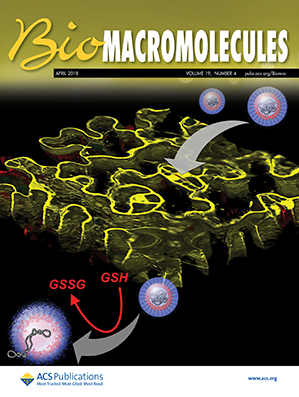Ion-Mediated Cross-Linking of Hyaluronic Acid into Hydrogels without Chemical Modification
IF 5.4
2区 化学
Q1 BIOCHEMISTRY & MOLECULAR BIOLOGY
引用次数: 0
Abstract
Hyaluronic acid (HA) is a biomedically relevant polymer widely explored as a component of hydrogels. The prevailing approaches for cross-linking HA into hydrogels require chemically modifying the polymer, which can increase processing steps and complicate biocompatibility. Herein, we demonstrate an alternative approach to cross-link HA that eliminates the need for chemical modifications by leveraging the interactions between metal cations and the negatively charged, ionizable functional groups on HA. We demonstrate that HA can be cross-linked with the bivalent metal cations Mn(II), Fe(II), Co(II), Ni(II), Cu(II), Zn(II), Pd(II), and notably Mg(II). Using Mg(II) as a model, we show that ion-HA hydrogel rheological properties can be tuned by altering the HA molecular weight and concentrations of ions, NaOH, and HA. Mg(II)-HA hydrogels showed the potential for self-healing and stimulus response. Our findings lay the groundwork for developing a new class of HA-based hydrogels for use in biomedical applications and beyond.
- Download: Download high-res image (94KB)
- Download: Download full-size image
离子介导透明质酸交联成水凝胶而无需化学修饰
透明质酸(HA)是一种生物医学相关聚合物,被广泛用作水凝胶的成分。将透明质酸交联成水凝胶的主流方法需要对聚合物进行化学修饰,这可能会增加加工步骤并使生物相容性复杂化。在此,我们展示了一种交联 HA 的替代方法,它利用金属阳离子与 HA 上带负电荷的可电离官能团之间的相互作用,无需进行化学修饰。我们证明了 HA 可以与二价金属阳离子 Mn(II)、Fe(II)、Co(II)、Ni(II)、Cu(II)、Zn(II)、Pd(II),尤其是 Mg(II)交联。以 Mg(II) 为模型,我们发现离子-HA 水凝胶的流变特性可以通过改变 HA 分子重量以及离子、NaOH 和 HA 的浓度来调节。镁(II)-HA 水凝胶具有自我修复和刺激响应的潜力。我们的研究结果为开发一类新的基于 HA 的水凝胶奠定了基础,这种水凝胶可用于生物医学应用及其他领域。
本文章由计算机程序翻译,如有差异,请以英文原文为准。
求助全文
约1分钟内获得全文
求助全文
来源期刊

Biomacromolecules
化学-高分子科学
CiteScore
10.60
自引率
4.80%
发文量
417
审稿时长
1.6 months
期刊介绍:
Biomacromolecules is a leading forum for the dissemination of cutting-edge research at the interface of polymer science and biology. Submissions to Biomacromolecules should contain strong elements of innovation in terms of macromolecular design, synthesis and characterization, or in the application of polymer materials to biology and medicine.
Topics covered by Biomacromolecules include, but are not exclusively limited to: sustainable polymers, polymers based on natural and renewable resources, degradable polymers, polymer conjugates, polymeric drugs, polymers in biocatalysis, biomacromolecular assembly, biomimetic polymers, polymer-biomineral hybrids, biomimetic-polymer processing, polymer recycling, bioactive polymer surfaces, original polymer design for biomedical applications such as immunotherapy, drug delivery, gene delivery, antimicrobial applications, diagnostic imaging and biosensing, polymers in tissue engineering and regenerative medicine, polymeric scaffolds and hydrogels for cell culture and delivery.
 求助内容:
求助内容: 应助结果提醒方式:
应助结果提醒方式:


